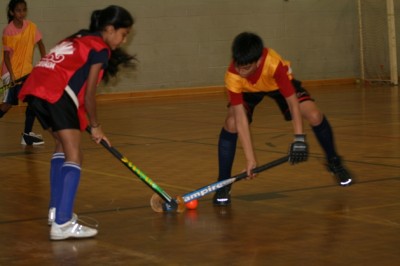
Males Age 9-12; Females Age 8-11
In this stage attention now focuses on building the athlete’s foundation of movement skills and begins to expand the repertoire of hockey basics. Participation in multiple physical activities and sport is still promoted with field hockey-specific activities recommended 2-3 times per week.
This is the most important stage for the development of field hockey-specific skills as it is a period of accelerated learning of coordination and fine motor control. It is also a time when children enjoy practicing skills they learn and seeing their own improvement. It is still too early for specialization in field hockey or at the specific positions. Athletes should continue to engage in a broad range of activities and sports for full athletic development.
This stage will feature the window of trainability for skill development for most athletes. Therefore it is important to provide athletes with sufficient time and repetitions to practice and master basic field hockey skills. For best long-term results 75% of the time in field hockey should be spent in practice, with only 25% of the time spent on competition. Applying the skills learned in practice should be the focus of competition, not winning.
Physical
Greater emphasis is placed on learning sport-specific movement through training. Strength training should consist of use of body weight and stability/medicine balls. Endurance and speed should be trained through fun and games that includes introduction to basic training concepts.
Early information about nutrition and hydration is provided.
A major skill learning window (the skill hungry years) takes place during this stage.
Technical
Developing the skills – continued emphasis on refinement of the Five FunStix Principles of Hockey and the expansion of these starts to occur.
Hockey skill introduction: Reverse stick and one-handed dribbling, eliminating, hitting, flicking, sweeping, open receiving, and poke tackling. All skills to be trained in both stationary and dynamic positions. Participants refine basic hockey skills such as open stick dribbling, using the reverse side of the stick, and pushing.
Goalkeeping: The goalkeeper position is introduced with participants focusing on angles, stopping the ball with their feet and pads, and low clears.
Participants compete in mini and modified games ( e.g., 3 vs. 3; 4 vs. 4). Modified implies selecting one or two basic skills to focus on during mini games.
Tactical
Slowly expand from mini games of 3 vs. 3 to 7 vs. 7 with an emphasis on numerical advantage, i.e., 2 vs. 1; 3 vs. 2 and ball possession. Add modified games involving positioning, including a goalkeeper, to introduce basic tactical play, e.g., width and depth, use of space.
Work in a small area with a modified goal and, for example, no “D”. Create awareness of the importance of teamwork and promote constructive communication.
Mental
Concepts of mental preparation begin to be introduced to the athlete. These include relaxation (deep breathing / ratio breathing), long and short term goal-setting, basic focus strategies and thought stopping, imagery (to promote skill development, control, and confidence), self-awareness, basic confidence building-ability to identify strengths, teamwork, and communication skills.
Rules of the Game are expanded and principles of fair play are understood.
Some implications for the coach: Introduce players to a structured mental training (MT) program, introduce the basic mental skills, introduce breathing exercises, and PMR (progressive muscular relaxation)
Health
Activities balance one-sided skills with variety of play activities with opposite movement patterns. A period of rapid growth may begin at the end of this stage for early maturers.
Nutrition: Ensure adequate nutrition, but avoid over-eating. Optimize hydration.
Strength and Flexibility: Introduce plyometric activity through common games (hopscotch, jump rope), shoulder and torso exercises, and free weight technique, but no maximal or near-maximal strength activities to preserve growth plates.
Injury Prevention: Balance one-sided skills with variety of play activities with opposite movement patters and wear properly fitting shoes.

